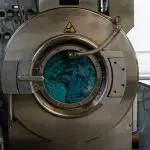If you’re someone who loves crafting, DIY projects, or home repairs, then you’ve most likely used E6000 adhesive at some point. This versatile adhesive is known for its strength and ability to bond many different materials, from wood to metal to fabric.
However, one question that always seems to come up is: how long does it take for E6000 to dry? The answer to this question isn’t always straightforward, as the drying time can vary depending on a variety of factors.
In this article, we’ll explore the average drying time for E6000, as well as ways to accelerate the process and ensure a strong, long-lasting bond. Whether you’re a seasoned E6000 user or a beginner, understanding how this adhesive works and how long it takes to dry is essential for any successful project.
Table of Contents
Understanding E6000 Adhesive
You’ll want to make sure you give E6000 adhesive enough time to dry completely before moving on to the next step. It can take anywhere from 24 to 72 hours depending on the temperature and humidity in your workspace. This adhesive is a popular choice for crafters and DIY enthusiasts because of its strong hold and versatility. It can bond to a variety of surfaces, including metal, glass, leather, and plastic.
One important thing to keep in mind when using E6000 adhesive is that it’s not a quick-drying glue. You’ll need to allow plenty of time for it to set and cure before handling or moving your project. If you’re working with a large or intricate piece, it’s best to apply the adhesive in sections and let each section dry completely before moving on to the next.
To speed up the drying process, you can try using a fan or setting up a dehumidifier in your workspace. However, be careful not to place your project too close to the fan, as this can cause the adhesive to dry unevenly or form bubbles.
With a little patience and careful attention to the drying process, you can achieve a strong and long-lasting bond with E6000 adhesive.
Average Drying Time
So, you wanna know more about the average drying time of E6000 adhesive? Well, there are a few factors that can affect this, such as the materials being bonded, the temperature, and the humidity.
These factors can all play a role in how quickly or slowly the adhesive dries, so it’s important to take them into consideration when using E6000. By understanding these key points, you can ensure that you get the most out of your adhesive and achieve the best possible results.
Factors Affecting Drying Time
If you’re in a hurry to finish your project, keep in mind that certain factors can affect how quickly E6000 adhesive dries. The drying time of E6000 can range from 24 to 72 hours depending on different factors.
Here are some factors that can affect how long it takes for E6000 to dry:
-
Humidity: High humidity can slow down the drying process of E6000. It’s recommended to use E6000 in a dry environment to ensure the fastest possible drying time.
-
Temperature: The temperature of the environment can also affect the drying time of E6000. Higher temperatures can speed up the drying process, while lower temperatures can slow it down.
-
Thickness of the Glue: The thicker the layer of E6000 applied, the longer it will take to dry. It’s recommended to use E6000 in thin layers for quicker drying time.
By keeping these factors in mind, you can ensure that your project using E6000 adhesive dries as quickly and efficiently as possible.
Materials Being Bonded
When bonding materials with E6000, make sure to consider the type of materials being used to ensure the strongest bond possible. The drying time of E6000 can vary depending on the materials being bonded together.
For example, if you’re bonding two non-porous surfaces such as metal or glass, the drying time may take longer compared to porous materials such as fabric or wood. This is because E6000 needs to penetrate the surface of the material to create a strong bond.
Additionally, certain materials may require a primer to be applied prior to bonding with E6000. This is especially true for plastics, which can be difficult to bond without a primer. The primer helps to prepare the surface of the plastic, making it easier for E6000 to adhere to it.
It’s important to read the manufacturer’s instructions for both E6000 and any materials being bonded together to ensure the strongest bond possible and the appropriate drying time.
Temperature and Humidity
To achieve the strongest bond possible with E6000, you need to consider the temperature and humidity levels in your workspace.
The ideal temperature for E6000 to dry and cure is between 70-85°F (21-29°C). If the temperature falls below this range, the curing process will slow down, and the bond may not be as strong as it could be. On the other hand, if the temperature is too high, the glue may dry too quickly, resulting in a weaker bond.
Humidity levels can also affect the drying time and strength of the bond. High humidity can slow down the evaporation process, making it take longer for the glue to dry and cure. This can also result in a weaker bond.
It is recommended to work in an environment with a humidity level of 50% or less when using E6000.
By taking these factors into consideration, you can ensure that the E6000 has the optimal conditions to dry and cure, resulting in a strong and long-lasting bond.
Handling Time
You’ll be pleased to know that E6000 only takes about 24 hours to fully dry, so be patient and avoid handling your project until then. This handling time is important to ensure that the adhesive has fully cured and will provide the strongest bond possible. Attempting to handle your project before the recommended drying time could result in the adhesive being weakened and your project not staying together as well as it could.
To make sure you’re allowing enough time for the E6000 to dry, it’s important to take into account the temperature and humidity of your workspace. Cooler temperatures and higher humidity levels can slow down the drying process, so make sure to work in an area with optimal conditions. You can also speed up the drying time by using a heat gun or hair dryer on a low setting, but be careful not to overheat the adhesive and cause it to become brittle.
It’s also important to note that the handling time may vary depending on the thickness of the adhesive application and the materials being bonded. To help ensure you’re giving your project enough time to dry, refer to the manufacturer’s instructions or do a small test application to gauge the drying time before fully committing to your project. By being patient and allowing the recommended handling time, you’ll be able to achieve a strong and secure bond with E6000 adhesive.
| Material | Dry Time |
|---|---|
| Fabric | 24-72 hrs |
| Plastic | 24 hrs |
| Metal | 24 hrs |
| Wood | 24-48 hrs |
| Glass | 24 hrs |
Table: Estimated E6000 drying times for common materials
Accelerating Drying Time
Now that you know about the handling time of E6000, let’s talk about how you can accelerate its drying time. Waiting for the glue to dry can be tedious, but luckily, there are a few things you can do to speed up the process.
Firstly, you can apply heat to the glue. Using a hairdryer or a heat gun on low heat can help dry the glue faster. However, be careful not to overheat the glue as it can cause it to become brittle and weaken its hold.
Another way to accelerate the drying time of E6000 is to add a small amount of acetone to the glue. This will help thin out the glue and make it dry faster. However, be cautious when adding acetone as too much can cause the glue to become too thin and affect its bonding strength.
Lastly, you can also try applying a small amount of pressure to the glued surfaces. This will help the glue spread evenly and bond faster. You can use clamps or even your fingers to apply pressure, but be sure not to move the glued surfaces as this can affect the bonding process.
Preparing Surfaces
Before starting to apply E6000, it’s important to ensure that the surfaces you will be bonding are clean and free of any dirt, dust, or debris. Any contaminants on the surface will weaken the bond and can cause the adhesive to fail. To prepare the surfaces, clean them thoroughly with a mild detergent and allow them to dry completely before applying E6000. You can also use rubbing alcohol or acetone to clean the surface, but be sure to test a small area first to ensure that it does not damage the material.
Once the surfaces are clean, it’s important to roughen them up to create a better bond. You can do this by lightly sanding the surface with fine-grit sandpaper or using a wire brush to create small scratches on the surface. This will provide more surface area for the adhesive to bond to and will help ensure a stronger bond. After roughening the surface, be sure to clean it again to remove any debris from the sanding process.
To help you understand the importance of preparing surfaces before using E6000, here is a table comparing the strength of a bond on a clean surface versus a surface with contaminants. The table shows that a clean surface will have a stronger bond than a surface that is not properly prepared. This reinforces the importance of taking the time to properly prepare the surfaces before using E6000 to ensure a strong and long-lasting bond.
| Surface Preparation | Strength of Bond |
|---|---|
| Clean Surface | Strong |
| Contaminated Surface | Weaker |
| Roughened Surface | Stronger |
Curing Time
After applying E6000 to your properly prepared surfaces, the bond will become stronger over time as the adhesive cures. The curing time of E6000 can vary depending on the amount of adhesive used, the temperature of the environment, and the humidity level.
Generally, E6000 takes 24 to 72 hours to fully cure, but it’s important to note that the bond will continue to strengthen for up to a week. During the curing process, it’s important to avoid disturbing the surfaces that are bonded with E6000. The adhesive may appear dry to the touch after a few hours, but it’s not fully cured and can easily be disrupted.
To ensure a strong bond, it’s best to allow the surfaces to remain undisturbed for at least 24 hours. This will give the adhesive enough time to fully cure and create a strong, permanent bond. As the adhesive cures, it’ll transition from a liquid to a solid state.
This process creates a strong, flexible bond that can withstand a wide range of environmental conditions. Once fully cured, E6000 is waterproof, heat-resistant, and able to withstand extreme temperatures. So, be patient and allow the adhesive to cure fully for the best results.
- How Does Ring Spun Cotton Affect Garment Fit and Shape Retention? - August 13, 2024
- What Are the Challenges in Producing Ring Spun Cotton? - August 13, 2024
- Is Ring Spun Cotton Suitable for Plus-Size Clothing? - August 13, 2024






